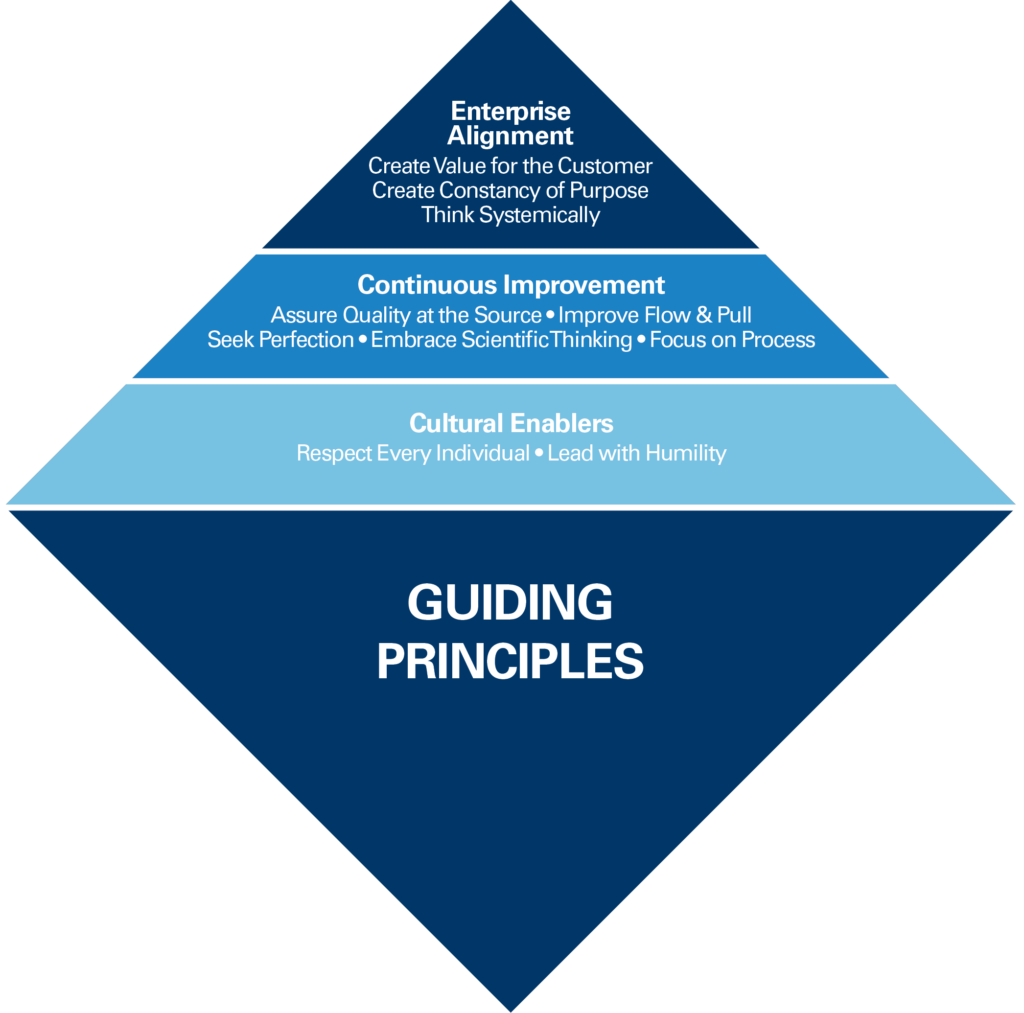Operational excellence is the journey towards perfection, but where do you start? Here's what you need to know about operational excellence in 2025.
When a business wants to stay ahead of the competition, it's important to examine what's happening inside the company. Here's our guide to achieving operational excellence in 2025.
Let's start by answering the key question: What is operational excellence?
An introduction to operational excellence
At its core, striving for operations management excellence means:
- Identifying problems
- Using problem-solving techniques to understand the scope
- Implementing process improvements, and
- Using measurements to ensure that process continually improves
Also known as OpEx, this journey involves principles, tools, and a model that emphasizes improving processes, assuring quality, and constantly seeking perfection.
After all, continuous improvement is better than delayed perfection.
The principles of operational excellence
Like any business strategy, ops excellence has a guiding ethos.
Operational excellence principles cover:
- Continuous improvement: Excellence is a continuous effort to improve products, services, or processes. These seek "incremental" improvement over time or "breakthrough" improvement simultaneously.
- Lean thinking: Lean manufacturing is a key part of business excellence. It focuses on cutting waste, such as excess inventory, unnecessary tasks, and inefficient workflows, to improve overall efficiency.
- Process optimization: Process is how you get from a-b, but OpEx acknowledges it's rarely a straight line, so you'll go through analysis and refinement of your business processes so that they're more effective and efficient. This could be automating repetitive tasks, improving workflow design, or enhancing supply chain logistics.
- Leadership commitment: Managers should encourage a culture where employees feel responsible for maintaining high standards and pursuing improvements. Leadership is crucial in setting a clear vision, engaging teams, and providing the support necessary for success.
- Data and metrics: Making data-driven decisions is vital to operational excellence. By measuring key performance indicators (KPIs), organizations can track progress, pinpoint areas for improvement, and ensure that changes lead to desired outcomes.
- Customer focus: Operational excellence improves the customer experience by delivering products and services more effectively and efficiently, better meeting customer needs, and quickly resolving issues.
- Empowering your team: Everyone is encouraged to contribute by spotting inefficiencies and suggesting improvements.
- Flexibility: OpEx enables your business to be more agile and flexible in adapting to new operational challenges.
- Safety: An often overlooked part of excellence is that it results in increased employee safety.
- Sustainability: Excellence initiatives naturally are made to consider the environment, meaning that practices are sustainable, reduce waste, and limit resource consumption.
By keeping these core operational management principles in mind, you can move towards setting your goals.
Operational excellence's goals
Because operational excellence is looking at the internal changes you can make, there are several goals that you can set:
- Create a culture of learning
- Add variety and minimize risking your business strategy's success in one area
- Optimize each operational process
- Reduce costs
- Eliminate waste
- Increase productivity
- Produce higher quality goods and services
- Improve customer satisfaction
- Drive innovation
- Sustain growth
- Ensure regulatory and legal compliance
- Find a new competitive advantage
These goals can vary depending on your strategy, but when sought at the same time, a multiplier effect results in considerable gains.
The Shingo Model
The operational excellence model is a framework for turning goals into tangible plans that can be delivered. Perhaps the most well-known model is the Shingo Model.

Image courtesy of the Shingo Institute
A Shingo system focuses on:
- Aligning the enterprise
- Continuous improvement, and
- Cultural enablement
And is underpinned by the Shingo guiding principles:
- Respecting each individual
- Leading with humility
- Seeking perfection
- Embracing scientific thinking
- Focusing on process
- Assuring quality at the source
- Improving flow and pull
- Thinking systematically
- Creating constancy of purpose
- Creating value for the customer
Click here to learn more about the Shingo model and principles.
With that in mind, your operational excellence model could be:
1. Leadership and Culture
- Leaders must demonstrate dedication to continuous improvement. They serve as the example and guide for the entire organization. This commitment is crucial for effective leadership. It sets the tone for the rest of the team.
- We want to create a culture of excellence. In this culture, all employees should feel empowered to contribute to improvement efforts. They should also be aligned with your values and goals.``
2. Continuous improvement
- Emphasize small, continuous changes in the workplace that compound to significant improvements over time.
- Encourage creative solutions for process improvement and problem-solving.
3. Process efficiency
- Utilize Lean tools to eliminate waste and streamline processes.
- Couple Lean with Six Sigma, a method that aims to improve quality by reducing variation, to follow a data-driven approach called DMAIC: Define, Measure, Analyze, Improve, Control.
4. Results orientation
- Establish clear metrics and key performance indicators (KPIs) to measure success and drive behavior.
- Ensure that departmental and individual goals align with the overall strategic objectives of the organization.
5. Enterprise alignment
- Ensure that all parts of the organization align effectively to execute the strategy.
- Promote cooperation across different departments to ensure seamless operations and optimal use of resources.
6. Customer focus
- Use Value Stream Mapping to identify the entire process flow from raw material to delivery to the customer. This helps streamline operations and enhance value.
- Keeps the focus on meeting and exceeding customer expectations through quality, delivery, and service.
7. Sustainability and safety
- Implement practices that reduce environmental impact and promote sustainability.
- Maintain high safety standards to ensure the well-being of employees and compliance with regulations.
Operational excellence tools
We've written about the tools available to operational and process managers. Here's our blog on core daily management tools, and here's a bonus list for projects.
But, as a refresh, operational excellence programs are brought to life with these:
1. Process improvement tools
- Lean Manufacturing: Tools like 5S (Sort, Set in order, Shine, Standardize, Sustain), Kanban (visual workflow management), and Just-in-Time (JIT) production.
- Six Sigma: DMAIC (Define, Measure, Analyze, Improve, Control), DMADV (Define, Measure, Analyze, Design, Verify) frameworks, and statistical tools.
- Total Quality Management (TQM): Focuses on continuous improvement of products, services, and processes by incorporating the knowledge and experiences of workers.
2. Problem solving tools
- Root Cause Analysis (RCA): Techniques like the 5 Whys, Fishbone Diagram, and Fault Tree Analysis to identify the underlying causes of problems.
- PDCA Cycle (Plan-Do-Check-Act): A method for iterative testing of changes to ways of working.
- A3 Problem Solving: A structured problem-solving and continuous-improvement approach, typically using a single sheet of ISO A3-size paper, which is a template to document the problem-solving process.
3. Data analysis tools
- Statistical Process Control (SPC): Uses statistical methods to monitor and control a process.
- Control Charts: Tool used to determine if a manufacturing or business process is in a state of control.
- Histograms: Help to visualize the distribution of data and identify patterns.
4. Performance measurement tools
- Key Performance Indicators (KPIs): Metrics used to evaluate success at reaching targets.
- Balanced Scorecard (BSC): A strategic planning and management system used to align business activities to the vision and strategy of your organization, the BSC improves internal and external communications and monitors organization performance against strategic goals.
- Benchmarking: Comparing your business processes and performance metrics to industry bests or best practices from other industries.
5. Waste reduction tools
- Value Stream Mapping (VSM): A lean-management method for analyzing the current state and designing a future state for the series of events that take a product or service from its beginning through to the customer.
- Poka-Yoke (Error Proofing): Techniques to avoid simple human error in the workplace.
6. Strategy execution tools
- Hoshin Kanri (Policy Deployment): A method for ensuring that the strategic goals of your company drive progress and action at every level within that company.
- Obeya Room: A large physical space that provides an overview of the project or business for strategic planning and cross-functional collaboration.
7. Quality improvement tools
- Quality Function Deployment (QFD): A process to ensure that the customer's needs are captured and converted into products and services.
- FMEA (Failure Modes and Effects Analysis): A step-by-step approach for identifying all failures in a design, a manufacturing or assembly process, or a product or service.
8. Employee engagement tools
- Gemba Walks: Leadership practice of visiting the shop floor to observe processes and engage with employees.
- Kaizen Events: Short-duration improvement projects with a specific aim for improvement.
When used at the right time and for the right purpose, these tools give you what you need to create high-quality products, services, and experiences.
Operational excellence organizational structures
Now that you know the guiding principles, model, and tools to use - what about your company's structure?
Generally, you want a structure that enables the three Cs: collaboration, communication, and continuous improvement.
There are nine ways to look at getting the structure you need:
1. Clear functional divisions
- Defined roles: Each department (e.g., Operations, Marketing, Finance, Human Resources) has clear roles and responsibilities that align with your business objectives.
- Specialization: Departments are structured around specialized functions that focus on core competencies, allowing for deeper expertise and efficiency.
2. Integrated teams
- Cross-functional teams: Teams with members from different departments work together on projects or initiatives. This promotes knowledge sharing and innovation while crushing silos.
- Program Management Office (PMO): A central team that oversees program and project management, ensuring that work aligns with strategic goals and is executed effectively.
3. Lean leadership
- Flat hierarchy: A flat organizational structure reduces layers of management, making communication open decisions faster. This empowers employees and bolsters responsiveness.
- Visible leadership: Leaders are actively involved in the operational aspects, not just strategically. They practice management by walking around (Gemba Walks) to connect with employees and understand the ground realities.
4. Flexible job roles
- Role fluidity: Job roles are designed to allow some flexibility, enabling employees to engage in different types of work within their teams or across the organization. This helps in skill development and job enrichment.
- Rotation programs: Employees rotate through different roles or departments to gain a broad understanding of the business, which can enhance collaboration and innovation.
5. Continuous improvement focus
- Dedicated continuous improvement teams: Specific teams or roles are dedicated to continuous improvement initiatives, such as Lean or Six Sigma specialists, who work across the organization to implement and monitor improvement projects.
- Training and development: Regular training programs to upskill employees in principles of operational excellence, such as problem-solving, process improvement techniques, and data analysis.
6. Performance measurement systems
- Integrated KPIs: Key Performance Indicators are designed to reflect departmental success and how well departments support each other and contribute to overall organizational goals.
- Regular reviews: Regular performance reviews and feedback sessions help align goals and provide course correction and recognition opportunities.
7. Customer-centric structure
- Customer service teams: Robust customer service teams that address complaints and proactively gather and use customer feedback to drive improvements.
- Direct feedback channels: Structures that allow direct communication between front-line employees and decision-makers to implement changes based on customer feedback quickly.
8. Technology and data integration
- Centralized data Systems: Implement systems like i-nexus that centralize data from different departments, making it easy to access and analyze information to drive decisions.
- Technology support teams: IT and technology teams that support operations and drive innovation in process automation and efficiency.
9. Safety and compliance
- Dedicated safety teams: Teams focused on maintaining and improving safety standards, ensuring compliance with laws and regulations, and reducing workplace risks.
With this in place, your company culture will be set up to enable you to achieve excellence. Above all, get your PMO set up right, and the rest will flow.
The last step is your strategy.
Operational excellence strategy
The final step in getting started with OpEx is to create your strategy.
As you can see, excellence reaches countless areas of your business. Let's narrow it down to three strategies to help create a thriving environment and improve the customer experience.
1. Employee empowerment and engagement
Objective: Increase job satisfaction, reduce turnover, and foster a culture where employees are motivated to achieve organizational goals.
Implementation: Develop programs to enhance employee skills, involve them in decision-making, and recognize their contributions.
Programs:
- Leadership training program: Develop and implement a training program for managers focused on leadership skills that promote inclusivity and employee engagement.
- Employee skill development workshops: Organize regular workshops and training sessions to enhance employees' knowledge of new technologies, methodologies, and soft skills.
- Employee recognition program: Establish a program that regularly recognizes and rewards employees for exceptional work and contributions.
KPIs:
- Employee turnover rate: Measure the percentage reduction in employee turnover annually.
- Employee satisfaction index: Regular surveys to gauge employee satisfaction levels.
- Participation rate in training programs: Percentage of employees participating in skill development and leadership training sessions.
- Number of employee suggestions implemented: Track the number of suggestions submitted by employees and how many are implemented.
2. Customer-centric approach
Objective: Enhance customer satisfaction and loyalty, leading to increased sales and market share.
Implementation: Align business processes to focus on customer needs, gather continuous feedback, and quickly adapt services or products based on customer insights.
Programs:
- Customer feedback system: Implement a real-time customer feedback system across all touchpoints to gather and analyze customer opinions and experiences.
- Customer journey mapping: Conduct detailed mapping of the customer journey to identify pain points and areas for improvement.
- Product/service adaptation initiatives: Regularly review customer feedback to adapt and modify products or services to better meet customer needs.
KPIs:
- Customer Satisfaction Score (CSAT): Measure satisfaction levels through customer surveys after interaction or purchase.
- Net Promoter Score (NPS): Assess how likely customers are to recommend the company’s products or services to others.
- Customer retention rate: Percentage of customers who remain engaged with the company over a specific period.
- Churn rate: Measure the rate customers discontinue their relationship with the company.
3. Just-in-Time (JIT) production
Objective: Reduce waste associated with overproduction and storage, improve cash flow, and speed up response to market changes.
Implementation: Align production schedules and materials orders with demand to reduce inventory costs and minimize warehouse space.
Programs:
- Demand forecasting system enhancement: Improve or implement advanced forecasting tools to better predict customer demand and reduce production overruns.
- Supplier integration program: Develop closer relationships and integration with suppliers to ensure timely and accurate materials delivery.
- Inventory management optimization: Implement systems and processes to optimize inventory levels and reduce excess storage.
KPIs:
- Inventory turnover ratio: Measure how often inventory is sold and replaced over a period.
- Cycle time: Track the total time from the start of production to the delivery of the product.
- Production lead time: Measure the time taken from order to shipment.
- Waste reduction: Quantify reductions in material waste and inefficiencies in production.
Get started with operational excellence
Every journey starts somewhere, so should you get advice and guidance. This guide is half of that step. The next is to download the tools you need.
For that, download a free copy of our operational excellence Excel template pack today to get started.
Learn more about strategy execution
Take the next steps in your journey by exploring our strategy execution resource hub.
About the author
Sam Ancliff is the Demand and Lead Generation Manager at i-nexus.
In his role, his drive is to provide leaders with the tools and insights they need to make next-level decisions in their businesses and organizations.
If you’d like to talk more about strategy, contact Sam at sam.ancliff@i-nexus.com or connect with him on LinkedIn for the latest insights.



